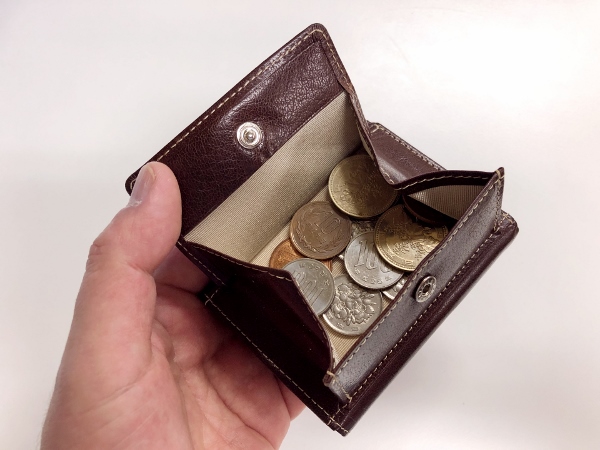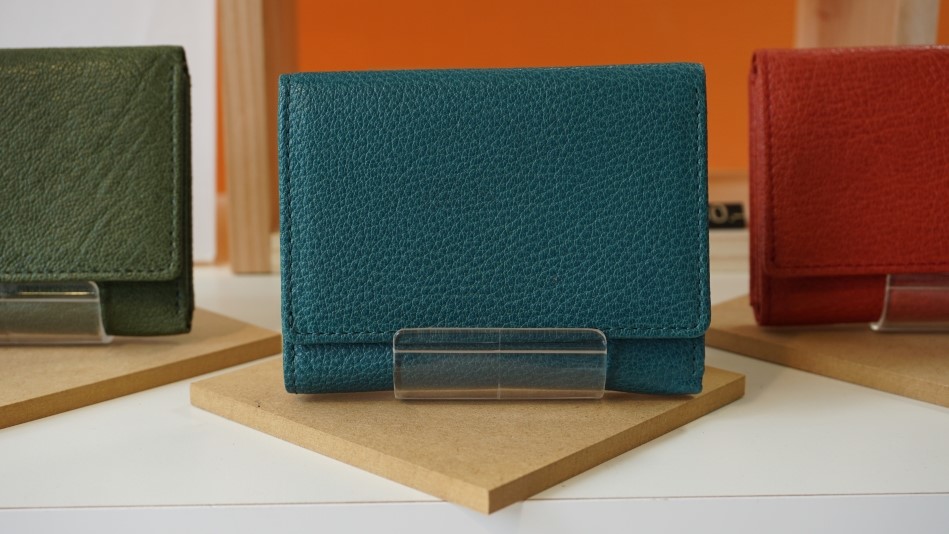Kiyosumi Shirakawa’s Small Wallet
Published: December 2, 2020
Tucked away in a quiet back street a short walk from Kiyosumi-shirakawa Station on the Toei Oedo Line is Carpenter Smith, a small workshop where the beautifully-made compact leather Kiyosumi Shirakawa Small Wallet is crafted.

On the day I met him, one of the first things I asked Mr. Taiji Nishimura, the younger of the two brothers who spend their days producing these wallets in the work space behind the counter of their shop, was the origin of the shop’s unusual name. It turns out that one of their grandfathers was a woodworker specializing in the construction of shrines; hence “carpenter”, whilst a forefather on the other side of the family used to forge and beat swords into shape; hence “smith”.

In a previous life, Mr. Nishimura worked in a business connected with cameras, but he enjoys using his hands to make things. A number of years ago, he was asked to join in a leather-working venture making goods for famous brand names, which they still do, and decided to branch out with his brother. The result was the Carpenter Smith workshop, which opened in March 2020.
Whilst learning to work with leather and then honing his skills, Mr. Nishimura made various wallets, in his words “all the time pursuing the ideal wallet, which would be both compact and easy to use, and that I can be proud of”. He certainly seems to have achieved this with the Kiyosumi Shirakawa Small Wallet.

Why small wallets? “Well”, says Mr. Nishimura, “with the growth in the cashless society fewer coins are being carried and there is less need for wallets to have large spaces to hold coins, and there has been a trend amongst women for small, compact handbags and this wallet fits neatly into such bags”. Furthermore, it makes a stylish fashion statement for both women and men.

Mr. Nishimura designed Carpenter Smith’s small wallet to do what a normal large-sized wallet does: it holds 4 credit cards, which can easily be told apart and effortlessly slid from the wallet, along with space to hold ten thousand and smaller-denomination yen notes, whilst there is a box compartment (coin purse) on the rear of the wallet for holding several loose coins. With the trending to cashless payments, the wallet can hold up to 6 cards rather than a hoard of coins.

And unlike most wallets, the Kiyosumi Shirakawa Small Wallet fits neatly into the palm of the hand.


The leather used for the wallets is supplied by wholesalers who source from Italy, Pakistan, and Bangladesh where the skinning, tanning, curing, and dyeing take place.

The leather then arrives at Carpenter Smith, where in the cramped space behind the shop counter, Mr. Nishimura and his brother toil away at several specialised machines to complete the process of creating one of Carpenter Smith’s carefully-finished hand-crafted Kiyosumi Shirakawa Small Wallets.



Various leathers are employed, such as cow, sheep, water buffalo, pig, and goat, and, depending on the material, the finish comes in different sheens and textures. The feel of each type of leather differs, according to the hide used, with sheepskin, for example, being very soft to the touch. The leather used also determines the thickness, tapering, and shaping of the wallet. These elegant accessories currently come in 13 colours; one of the most popular being green, which is used with goatskin.
Costing between 12,980 yen and 17,980 yen (including tax), the wallets are the only items sold by Carpenter Smith, and they are made to last. In the event a button hook becomes loose, the brothers offer a replacement after-service.

If requested, Mr. Nishimura can customize a wallet, for example by adding an eyehole to allow a keychain to be attached, but to me it seems a shame to break the simple lines of the wallet’s elegant design.
So, if you are looking to treat yourself, or someone you care about, to an item of beautiful but practical crafted leather what better thing to do than call round to Carpenter Smith and check out their Kiyosumi Shirakawa Small Wallets?

* Before the corona virus, Carpenter Smith held workshops giving the public a chance to make something in leather. Currently this activity is suspended, but Mr. Nishimura hopes to resume as soon as possible.
Story and photographs by Jeremy Hutchinson


